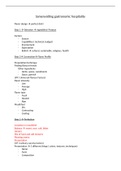Samenvatting gastronomic hospitality
Flavor design perfect dish!
Step 1 Selection ingrediënt/ Product
Factors:
- Season
- Capabilities ( technical, budget)
- Environment
- Expectation
- Beliefs cultural, sustainable, religious, health
Step 2 Connection Flavor Profile
Preparation/technique
Finding flavour friends
Other ingredients
- Herbs, spices, condiments
- Sauce, garnish
UFF ( Universal Flavour Factors)
Flavor intensity
- Low
- Average
- High
Flavor type
- Fresh
- Neutral
- Ripe
Mouthfeel
- Dry
- Contracting
- Coating
Step 3 Perfection
Variation in mouthfeel
Balance sweet, sour, salt, bitter
Umami
Mix of hard and soft textures
Pleasing aroma
Presentation
CSF ( culinary success factors)
Presentation 3 different things ( colors, textures, techniques)
- Name
- Form
- Composition
, - Quantity
Thrill
- Tingling several senses
- Temperature
- Element of surprise
- Creative/original
- Personality
Step 4 Reflection ( signature dishes, favorites)
Cravable
Stable
Refinement
Memorable
Gastronomic hospitality Summary
Flavor style contracting coating Flavour Food Beverages
richness
1 Neutral Neutral Neutral Low Rice, white bread, Plain water
zucchini,
poached/steamed
fish
2 Round Low High Low Spaghetti, milk Milk, wine
chocolate, with a touch
banana, melon, of sweetness
avocado, young
Gouda cheese,
butter, plain oil
3 Fresh High Low Low Apple, orange, Orange juice,
lemon, green acidic white
salad, pickle, wine such as
oyster, tomato, Sancerre,
fresh goat cheese, Muscadet,
vinegar Riesling
4 Balance High High Low Vinaigrette, Yogurt,
low creamy tomato balanced
sauce daily wine
5 Robust Dry Dry High Dark chocolate, Espresso,
grilled red meat strong tannic
red wines
with wood
character
6 Full Low High High Vanilla, caramel, Sweet,
whipped cream, concentrated
, vegetable oil, wine,
peanut butter fortified
wine
7 Pungent High Low High Peppermint, Some
Mustard, sparkling
Horseradish, Red wine
pepper, ginger,
spicy dishes
8 Balance High High High Braised meat, Rich, full-
High mushroom, bodied yet
umami balanced
wine (not
sweet)
Counterparts:
1 and 5
2 and 6
3 and 7
4 and 8
Umami:
Which could also be called “mouthfullness”. The type richness that influences mouthfeel
that is not from fat or sugar!!!
- Crispiness influences contracting
The role of the basic flavours:
Sweet
People like sweetness right from birth, they are natural preservatives, they contribute to
coating mouthfeel, or fullness. Sugars will generally lead to “ripe”. Sugars have the ability to
mask acidity and bitterness.
Fructose is directly related to forming fat, instead of glucose which is digested by insulin.
The use of more sugar in dishes is not without consequences for their combination with
wines. Wines that are completely dry, will appear to be more acidic, tart or sharp next to a
dish with sugar. This happens even when small amounts of sugars are used.
The combination rule is, therefore, that the grams of sugar in the wine and the dish should
be more or less equivalent.
Natural sweetness does not interfere with dry wines. Such as beets, carrots or baked onions.
Salt
Salt has an important influence on flavour richness, salt is predominantly fresh.
, It is an essential nutrient that fulfils many important roles in the body. Salt regulates the
water balance of the body, and the nervous system uses the sodium ion in the transmission
of electrical signals. You should not overconsume salt!!
Potassium Chloride is used instead of salt to reduce the sodium level. Its more bitter and
other substances are needed to cover up the effects.
Sour
Acidic products are mostly refreshing and often considered to be light and lively. In
mouthfeel, acidity is on the contracting side, and it stimulates saliva flow. Just like salt, acids
can be used as preservatives.
Natural fruits and vegetables contain acids, but there are different kinds. Citric acid is
present in oranges, lemons, limes, and other types of citrus fruits. Malic acid is typically
found in green apples but also in many other fruits. Lactic acid is associated with milky
flavours and is predominant in yogurt and sauerkraut. Oxalic acids is found in rhubarb and to
lesser extent in tomatoes and spinach. Carbonic acid gives the fizz to beverages and hardly
tastes sour.
Wine grapes contain primarily tartaric and malic and to a lesser extent citric acid. The
content of malic acid is directly associated with the grape variety and the climate. In warmer
regions or years, there is less malic acid. In the winemaking process, malic acid can be
broken down to lactic acid, which is softer. This is malolactic fermentation, can be used as a
tool to control acidity in a wine. When wine gets too old or oxidised it can turn into vinegar,
especially when enough oxygen is available. If a dish is already sour the wine will be
perceived as even more acidic, chose your wine carefully!!
Bitter
Few people will say they love bitter. Many toxins have a bitter flavour, this leads to the
suggestion that we need to be reprogrammed to learn that bitter may be not so bad after all.
Bitter flavors give dishes depth and character, can contribute to harmony and balance. Why
do we have bad feelings for bitter? There are problems on the receptor side and on the
tastant side. Humans are very sensitive to tasting bitter substances. Bitter is ripe and on the
contracting side.
Umami
Umami gives mouth fullness and roundness, and it is also described as balancing, blending
and as giving continuity, thickness and a general feeling of satisfaction. These effects on
flavour are attributed to glutamic acid, one of the most abundant off all amino acids found in
protein. Besides glutamate there are three kinds of acids that contribute to umami
sensation: inosinic acid found in animal sources; guanylic acid more abundant in plant based
foods and mushrooms; and adenylic acid, which is present in fish and shellfish.
Umami coating salt. Normal salts are contracting, but umami seems to interact with
saliva, making it fuller.
The role of the big four basic food molecules:
Water/moisture






